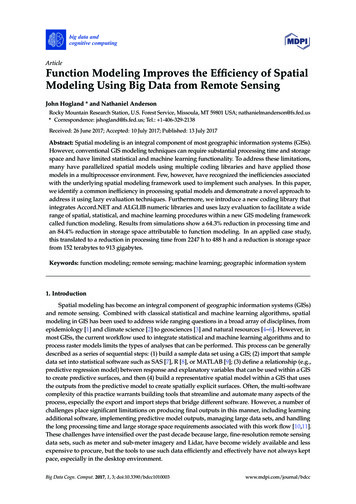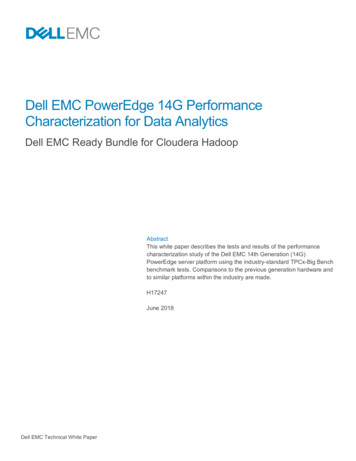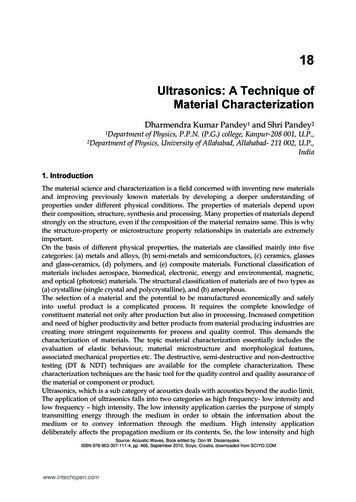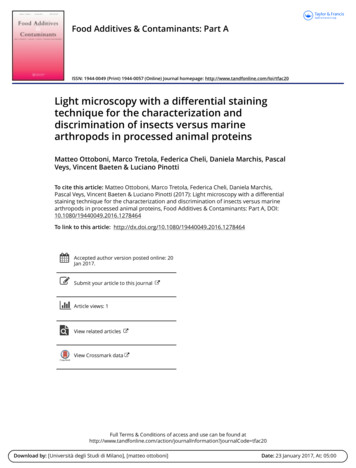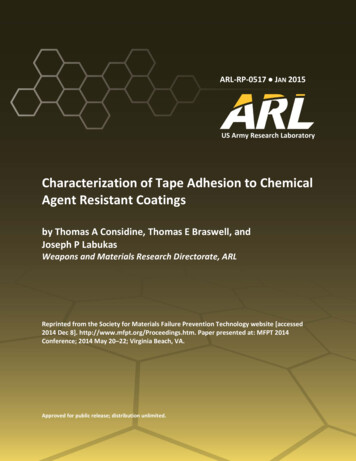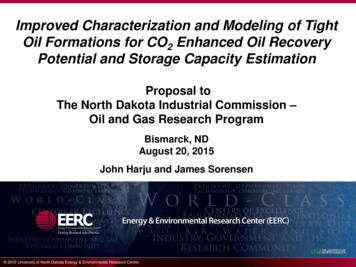
Transcription
Improved Characterization and Modeling of TightOil Formations for CO2 Enhanced Oil RecoveryPotential and Storage Capacity EstimationProposal toThe North Dakota Industrial Commission –Oil and Gas Research ProgramBismarck, NDAugust 20, 2015John Harju and James Sorensen 2015 University of North Dakota Energy & Environmental Research Center.
EERC Bakken CO2 Projects Bakken CO2 Storage and EOR Consortium – Phase I (2012-2014)––––Goal was to generate data and insight regarding the use of CO2 for Bakken EOR and CO2 storage.Vast majority of characterization efforts and all of the modeling efforts were focused on Middle Bakken.Hydrocarbon extraction work was roughly split between Middle Bakken and shales.MMP studies were conducted, including development of new capillary rise method. Bakken CO2 Storage and EOR Consortium – Phase II (2014-2016)–––––Goal is to support the deployment of CO2 injection operations for storage & EOR.Laboratory-, modeling-, and field-based activities.Emphasis is on selected Middle Bakken lithofacies, shales, and one zone of the Three ForksFormation.Improve modeling and simulation software for use in tight oil reservoirs.Design, implement, and monitor injection tests into one or more Bakken reservoirs. Improved Characterization and Modeling of Tight Oil Formations–––––––Goal is to assess and validate CO2 transport and fluid flow in fractured tight oil reservoirs.Determine the effects of wetting fluid on EOR and CO2 storage.Illuminate the roles that the shale members may play with respect to storage, containment, EOR, orpossibly all three.Advanced SEM and CT scanning techniques will be applied.Geomechanical testing will be conducted.Determine CO2 permeation rates and oil extraction rates in different lithofacies.Integrate laboratory data with the modeling to predict CO2 storage capacity & EOR potential.
Ultimate Goal of the Overarching Program:Injection Test into a Bakken Reservoir EERC activities will include:– Conducting minimum miscibility pressure (MMP)and hydrocarbon extraction studies on site-specificsamples.– Providing site-specific modeling support.– Working with the hosting operator to design andimplement an effective monitoring scheme todetermine the fate of the injected CO2 and itsimpact on the reservoir. Site host will obtain the CO2, conduct the injection andproduction activities, and provide relevant data to theproject team.
Comparison of Key Elements of EERC’s Past, Present, and Future Bakken Research ProjectsDifferences between ProjectsBakken CO2 Storage and EOR Consortium - Phase I (2012 – 2014)PartnersFundingUS DOE 675,000 cashNDIC 475,000 cashMarathon OilCompany 50,000 cash, 163,000 inkindContinentalResourcesTAQA North 50,000 cashGoals and Key Elements of Work PlanGoal was to generate data and insight regarding the use of CO2 for Bakken EOR and CO2 storage.A vast majority of the characterization efforts and all of the modeling efforts were focused on the MiddleBakken. The hydrocarbon extraction work was roughly split between Middle Bakken and shales.MMP studies were conducted, including support for the development of the new capillary rise method. 75,000 cashBakken CO2 Storage and EOR Consortium - Phase II (2014 – 2016)PartnersFundingUS DOE 2,623,558 cashCMG 467,000 in-kindKinder Morgan 250,000 in-kindBaker HughesSchlumbergerMarathon OilCompanyContinentalResourcesXTO EnergyHessGoals and Key Elements of Work PlanGoal is to support the deployment of effective CO2 injection operations for EOR & storage in the Bakken.Conducting a series of laboratory-, modeling-, and field-based activities to quantitatively determine the 994,407 in-kindeffects of injecting CO2 into the Bakken Formation from the perspectives of CO2 storage and EOR. 340,000 In-kindEmphasis is roughly equally split between work on selected lithofacies of the Middle Bakken and the shales,Currently unenumeratedwith one productive bench of the Three Forks also being part of the efforts.(core and data, thus far)Verify and validate the phenomena and mechanisms identified in Phase I with more robust data.Currently unenumerated (oil Working with CMG, Schlumberger, and Baker-Hughes to improve modeling and simulation software for usesamples and data, thus far)in tight oil reservoirs. Integrate the lab results in the improved software to more accurately model and 150,000 cash, 100k insimulate the complex processes that occur in these tight, fractured formations.kindDesign and monitor a pilot-scale injection test into one or more Bakken Petroleum System reservoirs. 250,000 cashImproved Characterization and Modeling of Tight Oil Formations for CO 2 Enhanced Oil Recovery & Storage (2014 – 2017)PartnersFundingUS DOE 2,500,000 cashNDIC-Lignite EnergyCouncil 250,000 cashNDIC-OGRC 400,000 cashGoals and Key Elements of Work PlanGoal is to assess and validate CO2 transport and fluid flow in fractured tight oil reservoirs.Determine the effects of the wetting fluid on EOR and CO2 storage. Illuminate the roles that the shale membersmay play with respect to CO2 storage, containment, EOR, or possibly even all three.Advanced SEM and CT scanning techniques that are not part of other efforts will be used to characterizefractures and pore networks at scales ranging from macro- to nanoscale.Geomechanical testing will be conducted to support development of improved hydraulic fracture models.Determine CO2 permeation and oil extraction rates in tight reservoir rocks and organic-rich shales. Integrate thelaboratory-based CO2 permeation and oil extraction data and the characterization data into geologic models anddynamic simulations to predict CO2 storage capacity and EOR in the Bakken.
Tight Oil Characterization and ModelingProject Sponsoring Partners
Other Tight Oil Characterization andModeling Project Participants
Bakken CO2 Storage and EnhancedRecovery Program Sponsoring Partners
Other EERC Bakken CO2 ProgramSupporters
Benefit to the State:Size of the Bakken Oil Resource Currently, only a 3%–10%recovery factor. Small improvements in recoverycould yield over a billion barrelsof oil. Can CO2 be a game changer inthe Bakken?
Challenges of EOR in Tight OilFormations Mobility and effectiveness of fluids through fractures relative to very low matrixpermeability. How will clays react to CO2? The role of wettability (oil-wet and mixed-wet) with respect to CO2 in tight oilreservoirs is not well understood. High vertical heterogeneity of the lithofacies complicates our understanding of flowregimes (fractures and matrix). Multiphase fluid flow behavior varies substantially depending on the size of thepore throats. Fluid viscosity and density are much different in nanoscale pores than inmacroscale pores. How does the sorptive capacity of the organic carbon materials affect CO2 mobility,EOR, and storage?10
HPMI Porosity“Poor Quality” Reservoir/ Lower Seal Pore sizes considered to be ageological barrier to injected fluids,including CO2 .Conventional Clastic Reservoir Dominant pore sizes fall within expectationsof traditional petroleum reservoirs.ConventionalBakkenU. Bakken ShaleMiddle Bakken
Pore Size Affects Fluid Phase BehaviorConceptual pore network model showing different phase behavior in different poresizes for a bubblepoint system with phase behavior shift.Source: Alharthy, N.S., Nguyen, T.N., Teklu, T.W., Kazemi, H., and Graves, R.M., 2013, SPE 166306, Colorado School of Mines,and Computer Modelling Group Ltd.
Improved Characterization and Modeling ofTight Oil Formations – Project ObjectivesThe project will result in improved tools and techniques to assess andvalidate fluid flow in tight oil formations resulting in an ability to bettercharacterize and determine their potential for CO2 storage and EOR. Develop methods to better characterize fractures and pores at the macro-,micro- and nanoscale levels. Identify potential correlations between fracture characteristics and otherrock properties of tight oil formations. Correlate core characterization data with well log data to better calibrategeocellular models. Evaluate CO2 permeation and oil extraction rates and mechanisms. Integrate the laboratory-based results into geologic models and numericalsimulations to assess CO2 EOR potential and storage capacity of tight oilformations.
Project Approach – Phase I(November 2014 to April 2016) Generate baseline rock properties data. Use advanced analytical technologies to characterize micro- andnanoscale fracture and pore networks. Assess Bakken reservoir and shale rock wettability and CO2 capillaryentry and breakthrough pressures at the Bakken reservoir‒shaleinterface. Hydraulically fracture rock core plugs of different lithofacies to determineeffects of different rock properties on fracturing. Correlate rock analysis data to well log data to predict the presence andcharacteristics of fracture networks.
Phase I Tasks to Be PerformedSample Selection and Baseline Characterization– Cores come from four locations.– Samples represent:– Middle Bakken reservoir lithofacies– Upper and Lower Bakken shale source rocks– Reservoir‒shale interface– Samples have been provided by Marathon andNDGS.– A suite of geochemical, geomechanical, andpetrophysical analyses are being performed.– CT, micro-CT, and advanced SEM analyses atIngrain and UND Hamm School of Geology &Geological Engineering
Current Phase I Activities Use CT scans to build matrix andfracture rock properties Lithofacies and variogram rangesfrom thin sections Pore quantification from SEM Import data into pore and corescale modelsExampleFE-SEM imagePore scale modeling
Core Sample Locations17
Project Approach – Phase II(May 2016 to October 2017) Determine CO2 permeation rates and oil extraction rates from samples ofBakken reservoir and shales using flow-through and static exposuretesting. Use multimineral petrophysical analysis (MMPA) to correlate well logs withlab characterization data, thereby more accurately distributing reservoirproperties throughout the static geomodels. Construct a geocellular model, and use it as the basis for numericalsimulations to estimate the CO2 EOR and storage potential of the Bakken. Integrate the results of the characterization and modeling activities topredict CO2 storage capacities and EOR potential in tight oil formations. Develop best practices manual (BPM) on the characterization and modelingof tight oil formations for CO2 EOR and storage.
Phase II Laboratory ActivitiesCO2 Transport, Permeation, and Oil Extraction Testing Determination of Permeation Rates in Reservoir Rocks– Flow-through permeability studies will be conducted to generateCO2‒brine relative permeability data. Determination of Permeation Rates in Shales– Innovative methods will be applied to generate CO2 permeation ratedata for samples of Upper and/or Lower Bakken shales. Evaluation of CO2-Soluble Tracers– Attempts to identify CO2 flow patterns will be made using a varietyof CO2-soluble tracers. Fluorescent dyes, UV-visible dyes, andorganometallic compounds will be tested. Hydrocarbon Extraction– Hydrocarbon extraction experiments will be performed on samplesof reservoir rocks and shale using the methods described inHawthorne and others (2013).
Phase II Modeling Activities MMPA Analysis– Core analysis data will be integrated with well log data for core-tolog calibration. Geocellular Modeling– MMPA results will be applied to develop a of a Bakken reservoirand shale system geocellular models in a single drill spacing unit. Simulations– Will be conducted on both Middle Bakken reservoirs and LowerBakken shales.– Single-well HnP, sequential multiwell HnP, and injector‒producerpairs.– Middle Bakken simulations will examine the effects of wettability.– Shale simulations will be oil-wet, but total organic content andhydrogen index will be varied to examine the effects of shalematurity.
Tight Oil Characterization and ModelingProject ScheduleStartDateEndDateTask 1 – Project Management and Planning11/1/201410/31/2017Task 2 – Sample Selection and Detailed 142/28/2015Phase I – Budget Period 12014Phase II – Budget Period 2201520162017Nov De c Jan Fe b Mar Apr May Jun Jul Aug Se p O ct Nov De c Jan Fe b Mar Apr May Jun Jul Aug Se p O ct Nov De c Jan Fe b Mar Apr May Jun Jul Aug Se p O ctM1M2D1D2D4D2D2D2D2D2D6D2D2D2D2D9D2M32.1 – Sample Identification and SelectionD3M42.2 – Laboratory Determination of Baseline .1 – Core-Scale Fracture Analysis2/1/20155/31/20153.2 – Macrofracture Characterization3/1/201510/31/20153.3 – Micro- and Nanoscale Fracture and Pore Analysis5/1/20152/29/2016Task 3 – Development of Improved Methodologies toIdentify Multiscale Fracture Networks and PoreCharacteristicsM5D5M63.4 – Development of Multiscale Pore and FractureModels7/1/20154/30/20165/1/0167/31/20174.1 – Determination of Permeation Rates in Tight,Fractured Reservoir Rocks5/1/201610/31/20164.2 – Determination of CO 2 Permeation Rates in OrganicRich Seal Rocks5/1/20162/28/20174.3 – CO 2 -Soluble Tracers5/1/20164/30/2017Task 4 – CO2 Transport, Permeation, and OilExtraction TestingM7D7M84.4 – Hydrocarbon Extraction5/1/20167/31/20175/1/201610/31/20175.1 – MMPA Analysis5/1/201610/31/20165.2 – Geocellular Modeling6/1/201612/31/2016Task 5 – MMPA, Modeling, and Simulation###M9M 10D8M 115.3 –Dynamic Simulation of Tight Oil FormationReservoirs and ShalesSummary TaskActivity BarMilestone (M)Critical PathDeliverable (D)Decision Point8/1/201610/31/2017Key for Deliverables (D)D1 – Updated Project Management Plan (PMP)D2 – Quarterly Progress ReportD3 – Sample Characterization Data SheetsD4 – Project Fact Sheet InformationD5 – Manuscript – Use of Advanced Analytical Techniques to Identify and CharacterizeMultiscale Fracture Networks in Tight Oil FormationsD6 – Phase I Interim ReportD7 – Manuscript – Laboratory-Measured CO 2 Permeation and Oil Extraction Rates in TightOil FormationsD8 – Best Practices Manual – Estimation of CO 2 Storage Resource of Fractured ReservoirsD9 – Final ReportKey for Milestones (M)M1 – Updated Project Management Plan Submitted to DOEM2 – Project Kickoff Meeting HeldM3 – First Samples Collected for CharacterizationM4 – Completion of Baseline Sample CharacterizationM5 – First Macroscale Fracture Data Sets GeneratedM6 – Completion of Fracture Network CharacterizationM7 – Completion of CO 2 Permeation TestingM8 – Completion of Hydrocarbon Extraction TestingM9 – MMPA Analysis CompletedM10 – Completion of Geocellular ModelsM11 – Completion of Simulations
Papers Generated ByEERC Bakken CO2 EffortsHawthorne, S.B., Gorecki, C.D., Sorensen, J.A., Steadman, E.N., Harju, J.A., Melzer, S., 2013, Hydrocarbon mobilization mechanismsfrom Upper, Middle, and Lower Bakken reservoir rocks exposed to CO 2. Paper presented at the SPE Unconventional ResourcesConference – Canada, Society of Petroleum Engineers, SPE 167200-MS.Hawthorne, S.B., Gorecki, C.D., Sorensen, J.A., Miller, D.J., Melzer, L.S., Harju, J.A., 2014, Hydrocarbon mobilization mechanisms usingCO2 in an unconventional oil play. Paper presented at GHGT-12, Energy Procedia, v. 63, p. 7717-7723, Elsevier.Klenner, R.C.L., Braunberger, J.R., Sorensen, J.A., Eylands, K.E., Azenkeng, A., and Smith, S.A., 2014, A formation evaluation of theMiddle Bakken Member using a multimineral petrophysical analysis approach: Paper presented at Unconventional ResourcesTechnology Conference – Denver, Colorado, USA, August 25-27, 2014, 9 p., URTeC: 1922735.Kurtoglu, B., Sorensen, J., Braunberger, J., Smith, S., and Kazemi, H., 2013, Geologic characterization of a Bakken reservoir for potentialCO2 EOR: Paper presented at 2013 Unconventional Resources Technology Conference, Denver, Colorado, August 12–14, URTeC 1619698.Liu, G., Sorensen, J.A., Braunberger, J.R., Klenner, R., Ge, J., Gorecki, C.D., Steadman, E.N., and Harju, J.A., 2014. CO 2-based enhanced oilrecovery from unconventional resources: a case study of the Bakken Formation: Presented at SPE Unconventional ResourcesConference, The Woodlands, Texas, April 1–3, 2014, SPE-168979-MS, 7 p.Sorensen, J.A., Hawthorne, S.A., Smith, S.A., Braunberger, J.R., Liu, G., Klenner, R., Botnen, L.S., Steadman, E.N., Harju, J.A., and Doll,T.E., 2014, CO2 Storage and Enhanced Bakken Recovery Research Program: Subtask 1.10 final report for U.S. Department of EnergyCooperative Agreement No. DE-FC26-08NT43291, May, 79 p.Sorensen, J.A., Braunberger, J.R., Liu, G., Smith, S.A., Klenner, R.C.L., Steadman, E.N., Harju, J.A., 2014, CO2 storage and utilization intight hydrocarbon-bearing formations: a case study of the Bakken Formation in the Williston Basin. Paper presented at GHGT-12,Energy Procedia, v. 63, p. 7852-7860, Elsevier.Sorensen, J.A., Hawthorne, S.B., Kurz, B.A., Braunberger, J.R., Liu, G., Smith, S.A., Hamling, J.A., Smith, S.A., Steadman, E.N., Harju, J.A.,2015, Characterization and evaluation of the Bakken Petroleum System for CO 2 enhanced oil recovery. Paper to be presented at 2015Unconventional Resources Technology Conference, San Antonio, Texas, July 20–22, URTeC 2169871.
Thank You!Andrew Burton/Getty Images
Contact InformationEnergy & Environmental Research CenterUniversity of North Dakota15 North 23rd Street, Stop 9018Grand Forks, ND 58202-9018World Wide Web: www.undeerc.orgTelephone No. (701) 777-5287Fax No. (701) 777-5181James Sorensen, Senior Research Managerjsorensen@undeerc.org
AcknowledgmentThis material is based upon work supported by the U.S. Department of EnergyNational Energy Technology Laboratory under Award No. DE-FC26-08NT43291.DisclaimerThis presentation was prepared as an account of work sponsored by an agency of theUnited States Government. Neither the United States Government, nor any agencythereof, nor any of their employees, makes any warranty, express or implied, or assumesany legal liability or responsibility for the accuracy, completeness, or usefulness of anyinformation, apparatus, product, or process disclosed or represents that its use would notinfringe privately owned rights. Reference herein to any specific commercial product,process, or service by trade name, trademark, manufacturer, or otherwise does notnecessarily constitute or imply its endorsement, recommendation, or favoring by theUnited States Government or any agency thereof. The views and opinions of authorsexpressed herein do not necessarily state or reflect those of the United StatesGovernment or any agency thereof.
permeation and oil extraction rates in tight reservoir rocks and organic-rich shales. Integrate the laboratory-based CO 2 permeation and oil extraction data and the characterization data into geologic models and dynamic simulations to predict CO 2 storage capacity and EOR in the Bakken. NDIC-Lignite Energy Council NDIC-OGRC 250,000 cash .




